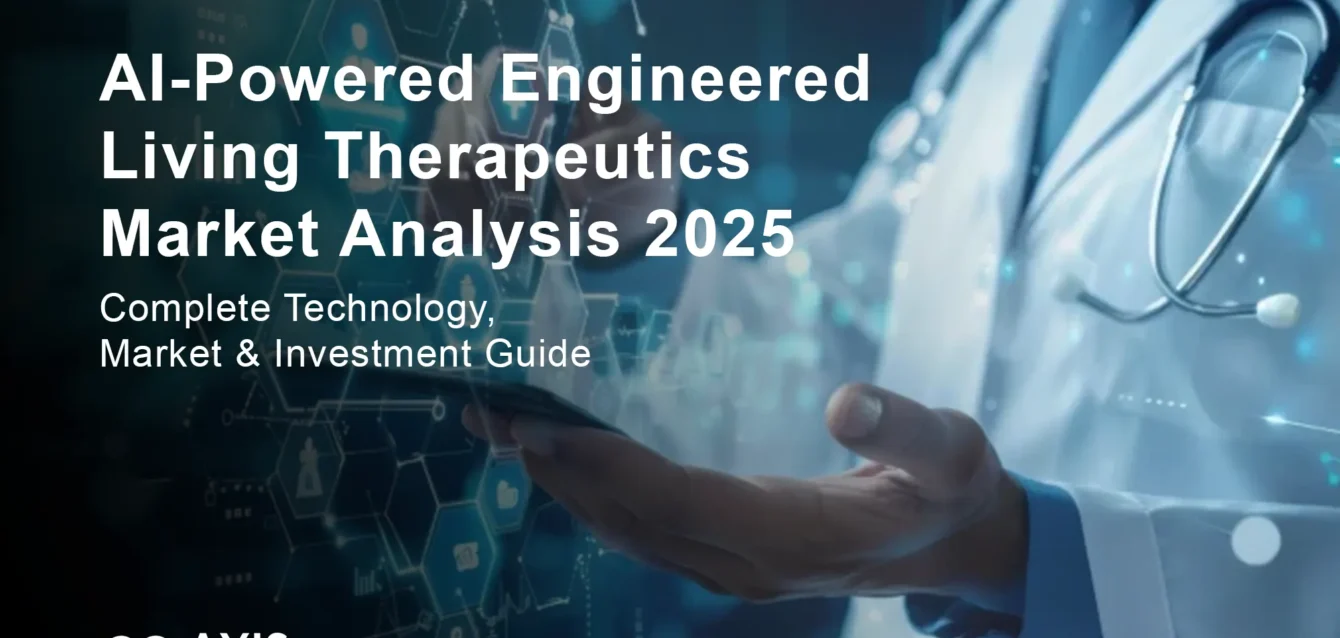AI-Powered Engineered Living Therapeutics Market Analysis 2025
What Are AI-Powered Engineered Living Therapeutics?
AI-Powered Engineered Living Therapeutics (AI-ELT) are genetically modified living cells or microorganisms enhanced with artificial intelligence algorithms that function as programmable therapeutic platforms. These systems use machine learning to sense disease biomarkers, compute optimal responses, and deliver targeted treatments in real-time. Unlike traditional pharmaceuticals, AI-ELT platforms adapt dynamically to patient conditions, offering personalized medicine through biological computation.
Key Characteristics:
- Machine learning-guided genetic programming
- Real-time therapeutic adaptation
- Biosensing and computational response
- Living cellular platforms with AI optimization
- Targeted disease treatment through algorithms
Artificial Intelligence is fundamentally transforming Engineered Living Therapeutics (ELT), creating a $47.2 billion convergence of machine learning, biotechnology innovation, and therapeutic artificial intelligence by 2032. This comprehensive analysis examines how AI algorithms, automated bioprocessing systems, and computational biology platforms are driving smart therapeutic development, from CRISPR optimization using deep learning to AI-guided clinical trial design and intelligent regulatory approval pathways. As living medicines transition from laboratory concept to commercial reality through intelligent automation and biotech AI solutions, this guide provides technology leaders, biotech executives, and AI practitioners with essential insights into the algorithms and data systems reshaping healthcare delivery through computational medicine and digital therapeutics platforms.
Table of Contents
- Executive Summary
- Market Size and Growth Analysis
- AI Technology Architecture
- Leading AI Platform Providers
- Global Market Dynamics
- Investment Analysis
- Therapeutic Applications
- Regulatory Framework
- Manufacturing Excellence
- Future AI Outlook
- Strategic Recommendations
- Frequently Asked Questions
Executive Summary: AI-Driven Transformation {#executive-summary}
Artificial Intelligence Foundation: Advanced Computational Bioengineering
AI-powered Engineered Living Therapeutics utilize machine learning algorithms and computational biology to optimize modular genetic frameworks comprising regulatory operations for gene expression control, biosensing modalities for environmental signal detection, and AI-optimized microbial chassis for therapeutic delivery. Current AI platforms integrate deep learning-enhanced CRISPR design, automated DNA synthesis optimization, and machine learning-guided manufacturing systems to create intelligent therapeutic computers capable of real-time biological programming.
AI-Biotech Market Convergence: $90.7 Billion Opportunity
The AI-enhanced synthetic biology market enabling smart therapeutic development expands from $21.9 billion (2025) to $90.7 billion (2032) at 22.5% CAGR, while machine learning applications in cell therapy platforms grow from $25.03 billion to $117.46 billion by 2034. North America leads AI-biotech integration with 42.1% market share, though Asia-Pacific demonstrates fastest AI adoption in healthcare at 18.91% CAGR.
Investment Landscape: AI-Driven Platform Consolidation
Strategic AI-biotech acquisitions include Bristol Myers Squibb’s $286 million acquisition of 2seventy bio’s AI-enhanced platforms, Regeneron’s $20 million investment in machine learning-guided therapeutics, and Pearl Bio’s $1 billion AI-powered collaboration with Merck. Over $3 billion in AI-enhanced synthetic biology funding demonstrates sustained investor confidence in computational therapeutic development.
AI-ELT Market Size and Growth Analysis
Comprehensive Market Data for AI-Powered Engineered Living Therapeutics
| Metric | 2025 | 2032 | CAGR |
|---|---|---|---|
| AI Synthetic Biology Market | $21.9B | $90.7B | 22.5%↗ |
| Cell Therapy Market | $25.0B | $117.5B | 18.7%↗ |
| AI-Biotech Investment | $3.0B+ | $15.0B+ | 25%+⬆ |
| Leading Region | North America (42.1%) | Global Expansion | Multi-Regional |
*Data compiled from industry reports, regulatory filings, and market research analyses. Projections based on current market trends and technological development patterns.
🔍 Key Market Insights
- Exponential Growth: AI Synthetic Biology market demonstrates 4.1x growth over 7 years
- Investment Surge: AI-Biotech funding expected to increase 5x by 2032
- Geographic Expansion: Market leadership shifting from regional to global distribution
- Technology Maturation: Higher CAGR in AI-enhanced sectors vs traditional biotech
- Market Convergence: Integration of AI, synthetic biology, and cell therapy markets
Market Drivers for AI-Enhanced Therapeutics
Technology Maturation Factors:
- Advanced machine learning bioengineering platforms enable reliable production of sophisticated AI-powered living therapeutics
- Artificial intelligence-enhanced design tools and automated computational manufacturing systems provide predictable therapeutic outcomes
- Deep learning algorithms optimize genetic circuit design and predict therapeutic efficacy through neural networks
Regulatory Support for AI Systems:
- FDA guidance for AI-powered live biotherapeutic products provides clear computational development pathways
- Clinical validation of AI-enhanced platforms supports accelerated commercialization timelines
- International regulatory harmonization for AI systems creates worldwide development opportunities
Investment Momentum in AI-Biotech:
- Billion-dollar strategic AI partnerships indicate long-term commitment to computational therapeutic development
- Sustained venture capital funding in AI-enhanced platforms demonstrates market confidence
- Pharmaceutical industry consolidation around artificial intelligence creates premium valuations
Top 5 AI-ELT Technology Applications {#technology-applications}
- AI-Enhanced CAR-T Cell Therapy – Machine learning optimization for cancer treatment with algorithmic tumor targeting
- Computational Tumor-Targeting Bacteria – Algorithmic precision for oncology applications using intelligent bacterial platforms
- AI-Powered Autoimmune Regulation – Intelligent T-cell engineering platforms for immune system modulation
- Smart Diabetes Management Systems – Glucose-responsive AI therapeutic platforms with real-time adaptation
- Algorithmic Microbiome Therapeutics – AI-guided bacterial medicine platforms for gastrointestinal disorders
AI-Enhanced Technology Architecture {#technology-architecture}
Core AI Platform Components and Intelligent System Design
Machine Learning-Optimized Genetic Engineering Framework
AI-powered ELT platforms employ three integrated computational modules:
1. AI-Driven Regulatory Operations Machine learning algorithms optimize CRISPR-Cas systems combined with computationally designed synthetic promoters and regulatory circuits to control gene expression with temporal and spatial precision. Advanced AI platforms utilize deep learning-enhanced dCas9-based transcriptional regulation and neural network-optimized RNA interference for intelligent therapeutic output control.
2. Intelligent Biosensing and Signal Processing AI-designed protein sensors detect disease biomarkers, environmental conditions, and therapeutic targets using computational biology approaches. Current implementations include machine learning-optimized engineered G-protein coupled receptors, AI-enhanced two-component bacterial sensing systems, and algorithmically designed synthetic riboswitches for molecular recognition.
3. AI-Optimized Therapeutic Chassis Engineering Computational biology platforms select and engineer optimized microbial platforms (E. coli Nissle 1917, Lactobacillus, engineered yeast) as intelligent delivery vehicles. AI-driven chassis selection considers colonization probability modeling, immunoregulatory response prediction, genetic manipulability algorithms, and protein secretion optimization through machine learning.
How AI Transforms Biotech Development
Step 1: AI Design → Machine learning algorithms optimize genetic circuits for therapeutic function Step 2: Computational Modeling → Predictive analytics simulate therapeutic outcomes and safety profiles Step 3: Automated Manufacturing → AI-controlled bioprocessing ensures consistent quality and scalability Step 4: Intelligent Monitoring → Real-time algorithmic adjustment of treatments based on patient response Step 5: Personalized Optimization → Machine learning adapts therapy to individual patient genetic and biomarker data
Advanced AI Manufacturing and Quality Systems
Commercial AI-powered ELT production requires sophisticated automated bioprocessing technologies:
- AI-Controlled Bioreactor Systems: Machine learning-optimized fed-batch and perfusion culture platforms with predictive analytics maintain cell viability and genetic stability throughout production cycles
- Automated Quality Control Analytics: AI-enhanced analytical methods including computer vision-guided flow cytometry, machine learning-optimized qPCR, and deep learning-enhanced next-generation sequencing
- Intelligent Cryopreservation Technologies: AI-optimized controlled-rate freezing algorithms and computationally designed storage media preserve engineered cell functionality
- Automated Fill-Finish Systems: AI-guided sterile manufacturing systems with predictive environmental monitoring prevent contamination while maintaining therapeutic potency
Leading AI Platform Providers {#platform-providers}
Enterprise AI-Biotech Platform Companies
Ginkgo Bioworks Operates AI-powered automated organism engineering platforms using machine learning-enhanced Design-Build-Test-Learn cycles. Their Foundry platform combines robotic automation, deep learning algorithms, and AI-guided high-throughput screening to accelerate strain development from months to weeks through computational optimization.
Tessera Therapeutics Develops AI-enhanced Gene Writing technology platforms that enable precise therapeutic modifications using machine learning algorithms to predict optimal targeting sites without double-strand DNA breaks, reducing genotoxicity risks while expanding targeting capabilities through computational biology.
Synthetic Biologics Develops AI-guided engineered microbial therapeutics for gastrointestinal and infectious diseases, demonstrating computational clinical proof-of-concept in multiple therapeutic areas through machine learning optimization and algorithmic therapeutic design.
AI Development Tool Ecosystem
Critical AI-Enhanced Technology Components:
- AI-Powered DNA Synthesis Platforms: Companies like Twist Bioscience provide machine learning-optimized silicon-based DNA synthesis enabling rapid prototyping of genetic circuits through computational design algorithms
- Intelligent Gene Editing Tools: AI-enhanced technologies include machine learning-guided base editing, computational prime editing, and algorithmically optimized epigenome editing for therapeutic applications
- Computational Design Software: AI-powered platforms like Benchling, Antha, and TeselaGen integrate intelligent design, automated experiment tracking, and machine learning-enhanced data analysis
Global Market Dynamics {#market-dynamics}
Regional AI-Biotech Adoption and Technology Implementation
North American AI Leadership The United States dominates AI-enhanced synthetic biology revenue with $6.9 billion (42.1% global share) in 2023, driven by:
- AI Regulatory Infrastructure: FDA guidance for AI-powered live biotherapeutic products provides clear computational development pathways
- Research Ecosystem: Integration between AI-focused academic institutions (MIT AI Lab, Stanford HAI, Harvard-MIT Broad Institute) creates computational innovation clusters
- AI Investment Capital: Venture funding in AI-biotech convergence exceeds $3 billion annually with major artificial intelligence hubs in Boston, San Francisco, and San Diego
- Corporate AI R&D: Pharmaceutical companies invest heavily in machine learning-enhanced ELT platforms through strategic algorithmic partnerships
Asia-Pacific AI Expansion Fastest-growing region (18.91% CAGR) demonstrates significant AI opportunities:
- China: Government AI biotechnology initiatives and intelligent manufacturing capabilities support rapid scaling
- Japan: AI precision medicine focus and aging population create market demand for computational therapeutics
- Singapore: AI biomedical hub with supportive regulatory environment attracts international biotechnology companies
- South Korea: AI technology integration and healthcare digitization accelerate therapeutic platform adoption
Competitive Analysis and AI Market Positioning
Established Pharmaceutical AI Integration:
Novartis leads AI-enhanced CAR-T cell therapy commercialization with machine learning-optimized Kymriah and continues computational platform expansion through internal AI R&D and strategic algorithmic partnerships.
Bristol Myers Squibb’s acquisition of 2seventy bio for $286 million demonstrates commitment to AI-powered cell therapy platforms, combining established commercial capabilities with innovative machine learning engineering technologies.
Regeneron’s $20 million investment in 2seventy bio with 100% clinical development funding illustrates AI-enhanced risk-sharing partnership models that accelerate computational therapeutic development.
AI Investment Analysis {#investment-analysis}
AI-Enhanced Funding Trends and Computational Investment Patterns
Venture Capital in AI-Biotech Convergence Artificial intelligence-enhanced synthetic biology and ELT companies raised over $3 billion in 2020-2021, with continued strong investor interest in computational platforms:
- AI-Driven Series A-B Funding: Early-stage companies typically raise $10-50 million for machine learning platform development and AI-guided preclinical validation
- Growth Capital for AI Platforms: Established computational platforms secure $50-200 million for AI-enhanced clinical trials and automated manufacturing scale-up
- Strategic AI Partnerships: Pharmaceutical companies provide $100 million+ for machine learning platform access and algorithmic co-development rights
Recent Major AI-Biotech Transactions
- Pearl Bio-Merck AI Collaboration: $1 billion partnership leveraging artificial intelligence for non-standard amino acid therapeutics demonstrates large-scale computational platform validation
- Esphera SynBio AI Seed Round: $2 million funding for machine learning-enhanced synthetic biology platform development
- LanzaTech AI Spin-out: LanzaX formation as joint venture shows alternative financing structures for AI-enhanced platform companies
AI Investment Risk Assessment
Technical Risk Factors in AI-Biotech:
- AI Model Complexity: Machine learning algorithms require extensive validation and may suffer from overfitting or bias in biological applications
- Computational Manufacturing Scalability: AI-driven bioprocessing systems face integration challenges and algorithm reliability at commercial scale
- Regulatory Uncertainty for AI Systems: Evolving approval pathways for AI-enhanced therapeutics and machine learning validation requirements
AI-Enhanced Risk Mitigation Approaches:
- Algorithmic Platform Diversification: Multiple AI therapeutic applications reduce single-algorithm dependency through computational redundancy
- Strategic AI Partnerships: Pharmaceutical company collaboration provides machine learning expertise and computational regulatory capabilities
- Staged AI Development: Milestone-based funding with algorithmic validation checkpoints manage capital deployment effectively
AI-Enhanced Therapeutic Applications {#therapeutic-applications}
AI-Powered Oncology Platforms
AI-Optimized Tumor-Targeting Bacterial Systems:
- AI-Guided Clostridium strains using algorithmic optimization selectively colonize hypoxic tumor environments
- Machine Learning-Enhanced Salmonella platforms target tumor-associated macrophages using computational cell recognition
- AI-Optimized E. coli Nissle variants engineered for inflammatory cancer environments with machine learning-controlled replication
AI-Enhanced CAR-T Cell Engineering:
- AI Logic Gating: Machine learning AND/OR gate circuits require multiple tumor antigens for activation, reducing off-target effects
- Computationally Controllable Expression: AI-guided small molecule-inducible systems enable temporal control of therapeutic activity
- AI-Armored CAR-T: Machine learning-optimized co-expression of cytokines and checkpoint inhibitors enhances anti-tumor activity
AI-Driven Autoimmune Disease Management
AI-Enhanced Regulatory T Cell Engineering:
- AI Antigen-Specific Tregs: Artificially intelligent engineered T cells provide targeted immune suppression through algorithmic specificity
- Machine Learning Tissue-Specific Homing: AI-optimized organ-selective trafficking reduces autoimmune inflammation
- AI Controllable Function: Machine learning conditional activation systems enable precise therapeutic control
AI-Powered Microbiome Therapeutic Platforms:
- AI Anti-Inflammatory Circuits: Artificial intelligence bacterial platforms produce immunomodulatory molecules using algorithmic sensing
- AI Barrier Function: Machine learning-engineered probiotics strengthen intestinal barrier integrity through computational optimization
- AI Metabolite Production: Artificial intelligence synthetic pathways generate beneficial metabolites for immune regulation
AI-Enhanced Metabolic Disease Interventions
AI-Powered Diabetes Management Platforms:
- AI Glucose-Responsive Insulin: Artificially intelligent engineered cells produce insulin using machine learning glucose sensors
- AI Incretin Mimetics: Machine learning bacterial platforms generate GLP-1 analogs for sustained glycemic control
- AI Beta Cell Replacement: Artificial intelligence protected cell encapsulation systems prevent immune rejection
AI-Enhanced Regulatory Framework {#regulatory-framework}
FDA Regulatory Pathway for AI-Powered Live Biotherapeutic Products
Current AI Regulatory Landscape The FDA regulates AI-enhanced ELTs as live biotherapeutic products (LBPs) through the Center for Biologics Evaluation and Research (CBER) with additional considerations for artificial intelligence components:
- AI-Enhanced IND Requirements: Investigational New Drug applications must include comprehensive characterization data for both biological components and AI algorithms
- AI CMC Considerations: Chemistry, Manufacturing, and Controls documentation requires detailed strain characterization, AI algorithm validation, and machine learning quality control methods
- AI Clinical Trial Design: Phase I-III studies must address unique safety considerations for AI-powered living therapeutics including algorithmic colonization models and computational persistence predictions
AI Safety and Computational Biocontainment Requirements
Regulatory agencies emphasize AI-enhanced containment strategies:
- AI Genetic Safeguards: Machine learning-designed kill switches, algorithmic auxotrophy, and computational containment circuits prevent environmental release
- AI Clinical Monitoring: Patient tracking using artificial intelligence for colonization patterns, immune responses, and adverse events
- AI Manufacturing Controls: Validated production processes with AI contamination prevention and intelligent quality assurance
International AI Regulatory Harmonization
European Medicines Agency (EMA) AI Approach:
- AI Environmental Risk Assessment: Machine learning evaluation of potential ecological impact from artificially intelligent engineered organisms
- AI Clinical Trial Regulation: Streamlined approval process for multi-national studies using computational platforms
- AI Advanced Therapy Medicinal Products: Specific regulatory pathway for AI-enhanced cell and gene therapies
Asia-Pacific AI Regulations:
- Japan PMDA AI: Harmonized approach with FDA and EMA for multinational AI development using computational frameworks
- China NMPA AI: Accelerated approval pathways for AI-powered innovative therapeutics using machine learning validation
- Singapore HSA AI: Regulatory sandbox for AI-enhanced novel therapeutic modalities using computational testing
AI-Driven Manufacturing Excellence {#manufacturing}
AI-Enhanced Commercial Manufacturing Strategies
AI-Optimized Facility Design and Operations:
- AI Containment Systems: Biosafety level 2+ facilities with machine learning environmental monitoring and algorithmic emergency protocols
- AI Process Development: Scale-up from laboratory to commercial production with AI process analytical technology and machine learning optimization
- AI Quality Control: In-process monitoring and release testing using artificial intelligence and computational validation methods
- AI Supply Chain: Cold chain distribution optimized through machine learning logistics and algorithmic inventory management
AI Technology Transfer and Computational Scale-Up
Critical considerations for AI-enhanced commercial production:
- AI Process Robustness: Validated manufacturing procedures with machine learning-acceptable variability ranges and algorithmic process control
- AI Analytical Methods: Qualified assays for identity, purity, potency, and safety testing using artificial intelligence and computational validation
- AI Facility Qualification: Installation, operational, and performance qualification protocols enhanced with machine learning monitoring
- AI Technology Transfer: Systematic approach using computational optimization and artificial intelligence for commercial manufacturing
AI Cost Structure and Economic Considerations
AI Manufacturing Cost Analysis:
- AI Raw Materials: 20-30% of costs, optimized through machine learning procurement and algorithmic supply chain management
- AI Facility Operations: 40-50% of expenses, reduced through artificial intelligence automation and intelligent process control
- AI Quality Control: 15-25% of total costs, streamlined through computational validation and automated testing systems
- AI Technology: 10-15% of operational expenses, optimized through machine learning predictive maintenance and algorithmic optimization
AI Economic Optimization Strategies:
- AI Process Intensification: Higher cell densities and productivity through machine learning optimization and algorithmic control
- AI Automation: Robotic systems and AI process control reduce labor costs and improve consistency
- AI Outsourcing: Contract manufacturing organizations provide cost-effective production using computational platforms
- AI Technology Innovation: Advanced bioprocessing technologies improve efficiency through machine learning optimization
Future AI Technology Outlook {#future-outlook}
Emerging AI Technology Convergence
Advanced Artificial Intelligence Integration:
- Predictive AI Modeling: Deep learning algorithms optimize genetic circuit design using neural networks trained on biological datasets
- AI Manufacturing Optimization: Real-time machine learning process control and predictive quality algorithms improve production efficiency
- AI Clinical Trial Design: Patient stratification algorithms and endpoint optimization accelerate development timelines through computational intelligence
- AI Drug Discovery: Machine learning-guided target identification and algorithmic therapeutic pathway analysis
Next-Generation AI Engineering Platforms:
- AI-Enhanced Base Editing: Machine learning algorithms enable precise nucleotide changes through computational optimization of editing efficiency
- Intelligent Epigenome Editing: AI-driven reversible gene expression changes provide therapeutic programming options through algorithmic control
- AI Protein Engineering: Machine learning-guided directed evolution and computational design create novel therapeutic effectors
- Smart Delivery Systems: AI-optimized vectors and intelligent targeting technologies improve therapeutic localization through algorithmic guidance
AI-Driven Personalized Medicine Integration:
- AI Biomarker-Guided Therapy: Machine learning algorithms analyze patient-specific molecular signatures to direct computational therapeutic programming
- Adaptive AI Treatment: Real-time algorithmic monitoring enables dynamic therapeutic adjustment through intelligent feedback systems
- AI Companion Diagnostics: Integrated diagnostic and therapeutic platforms optimized by machine learning enhance patient selection
- AI Pharmacogenomics: Genetic variation analysis using artificial intelligence guides dosing and safety monitoring
Strategic Recommendations {#recommendations}
For AI Technology Companies
- AI Platform Development: Focus on modular, scalable artificial intelligence architectures that address multiple therapeutic applications through machine learning algorithms
- Computational Manufacturing Excellence: Invest in AI-driven automated bioprocessing and intelligent quality control systems for commercial scalability
- AI Regulatory Strategy: Engage early with regulatory authorities to establish clear development pathways for machine learning-enhanced therapeutics
- AI Partnership Strategy: Collaborate with pharmaceutical companies for computational clinical expertise and AI-enhanced commercial capabilities
For AI Investors and Technology-Focused Financial Institutions
- AI Due Diligence Focus: Evaluate artificial intelligence platform breadth, machine learning manufacturing capabilities, and computational regulatory strategy
- AI Portfolio Construction: Diversify across therapeutic areas, AI development stages, and geographic regions with algorithmic expertise
- AI Exit Strategy: Monitor pharmaceutical industry acquisition activity for AI-enhanced platforms and computational IPO market conditions
- AI Risk Management: Implement milestone-based funding for machine learning validation and maintain diversified artificial intelligence investment portfolios
For Pharmaceutical Companies Adopting AI
- AI Platform Evaluation: Assess AI-powered ELT technologies for strategic fit with existing therapeutic areas and computational capabilities
- AI Investment Strategy: Balance internal machine learning development with external AI partnerships and algorithmic acquisitions
- AI Manufacturing Integration: Develop specialized capabilities for AI-driven living therapeutic production and intelligent quality control
- AI Commercial Preparation: Build market access and physician education capabilities for AI-enhanced therapeutic modalities
The AI-Biotech Convergence
AI-Powered Engineered Living Therapeutics represents a transformative convergence of advanced artificial intelligence, sophisticated biotechnology, substantial market opportunity, and strategic investment that positions this field as a cornerstone of future computational medicine. The sophisticated integration of machine learning platforms, AI-enhanced CRISPR engineering, and automated intelligent manufacturing creates unprecedented therapeutic capabilities that address previously intractable medical challenges through artificial intelligence.
Key Strategic AI Takeaways:
- AI Technology Leadership: Modular computational platform approaches and intelligent manufacturing excellence create sustainable competitive advantages through artificial intelligence
- AI Market Timing: Regulatory clarity for AI systems and clinical validation support accelerated commercialization timelines for machine learning platforms
- AI Investment Opportunity: Platform breadth, strategic AI partnerships, and multiple therapeutic applications justify premium valuations for computational companies
- AI Global Expansion: International regulatory harmonization for AI systems and emerging market adoption create worldwide growth opportunities
- AI Future Innovation: Advanced machine learning integration, personalized computational medicine, and next-generation AI engineering tools expand therapeutic possibilities
The AI-powered engineered living therapeutics field stands at a critical inflection point where technological sophistication, market demand, and investment capital align to enable a new era of computational programmable medicine that will reshape therapeutic development across oncology, autoimmune diseases, metabolic disorders, and emerging therapeutic areas through sophisticated artificial intelligence bioengineering platforms.
FAQ: AI-Powered Engineered Living Therapeutics {#faq}
What is an AI-powered engineered living therapeutic?
An AI-powered engineered living therapeutic is a genetically modified living cell enhanced with machine learning algorithms that can sense disease conditions, compute optimal treatments, and deliver targeted therapy in real-time within the human body.
How big is the AI biotech market in 2025?
The AI-enhanced synthetic biology market reaches $21.9 billion in 2025, projected to grow to $90.7 billion by 2032 at 22.5% CAGR, driven by machine learning applications in therapeutic development.
Which companies lead AI-powered ELT development?
Leading companies include Ginkgo Bioworks (AI organism engineering), Novartis (AI CAR-T platforms), Bristol Myers Squibb (acquired AI-enhanced 2seventy bio), and Tessera Therapeutics (AI gene writing technology).
What are the main AI applications in living therapeutics?
Key applications include AI-enhanced CAR-T cancer therapy, computational tumor-targeting bacteria, intelligent autoimmune regulation, smart diabetes management, and algorithmic microbiome therapeutics.
How does AI improve therapeutic manufacturing?
AI optimizes manufacturing through machine learning process control, predictive quality analytics, automated bioprocessing systems, intelligent contamination prevention, and algorithmic supply chain optimization.
What regulatory challenges face AI-powered therapeutics?
AI-enhanced therapeutics require FDA validation of both biological components and machine learning algorithms, comprehensive safety studies for computational systems, and AI biocontainment strategies.
Which regions offer best AI-ELT investment opportunities?
North America leads with 42.1% market share and strong AI infrastructure, while Asia-Pacific shows fastest growth at 18.91% CAGR driven by AI manufacturing capabilities and regulatory support.
How much investment flows into AI-biotech platforms?
Over $3 billion invested in AI-enhanced synthetic biology companies, with major deals including Pearl Bio’s $1 billion AI collaboration with Merck and Regeneron’s $20 million AI platform investment.
What makes AI-ELT different from traditional drugs?
AI-ELT platforms use machine learning for real-time adaptation, computational disease sensing, algorithmic therapeutic optimization, and personalized treatment adjustment, unlike static traditional pharmaceuticals.
When will AI-powered therapeutics reach market?
Several AI-enhanced platforms are in clinical trials, with first approvals expected 2026-2028, followed by rapid market expansion as AI regulatory frameworks mature and manufacturing scales.





